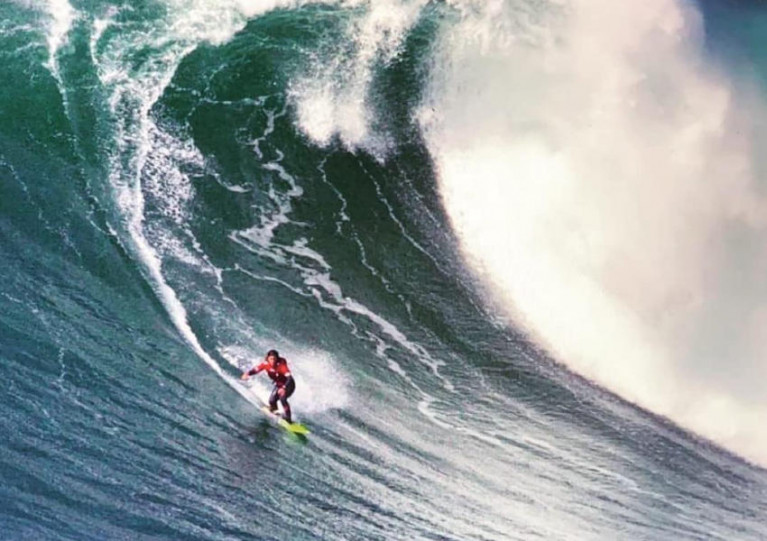Displaying items by tag: big wave surfing
The surfing world has paid tribute to Brazilian big wave surfer Marcio Freire after his death at Nazaré last Thursday (5 January).
According to RTÉ News, Freire fell into the water while surfing at the Portuguese swell regarded as producing the world’s largest waves.
Despite rescuers’ attempts to revive him on shore, Freire — known as ‘Mad Dog’ — was pronounced dead at the scene. He was 47.
It marks the first known fatal incident at Nazaré, where Irish-scene regular Andrew ‘Cotty’ Cotton suffered a potentially life-changing spinal injury in November 2017 — though he returned to ride the same waves three years later.
German big wave surfer Sebastian Steudtner holds the current record for the biggest wave ever surfed at 26.2 metres, set at Nazaré in October 2020.
RTÉ News has more on the story HERE.
A new documentary celebrating one of the few women big wave surfers to conquer the incredible swells at Nazaré in Portugal is screening next weekend as part of the virtual Virgin Media Dublin International Film Festival.
BIGvsSMALL follows courageous Portuguese surfer Joana Andrade as she confronts her fears of the water, and takes on an unusual training programme in the frozen lakes of Finland with a champion free diver revered in her own right.
The film streams next Sunday 16 March from 4pm for a limited time for viewers on the island of Ireland, and includes a Q&A with the director Minna Dufton hosted by film-maker Claire Dix.
Top Surfers Tackle Biggest Rollers in Years Off Mullaghmore
#SURFING - It may have been too late for the postponed Tow-In Surf Session, but the big waves at Mullaghmore Head finally picked up this week - and some of the world's top surfers were there to take advantage of the swell.
As The Irish Times reports, an extreme weather system nicknamed the 'Viking storm' helped produced monster rollers on Thursday that are the biggest the area has seen in 15 years.
Devon surfer Andrew 'Cotty' Cotton rode the biggest wave when he tackled a 50ft giant, assisted by his Irish tow-in partner Al Mennie, while Brit boarder Tom Butler recorded the biggest barrel.
Richie Fitzgerald described the scene as "very calculated madness", noting that a safety crew was on hand as the 16-strong group took on the "huge, unruly and very dangerous swell".
The Irish Times has much more on the story, while Surfer Today has more video of the last winter swell at Mullaghmore Head HERE.
No Tow-In Surf Session for 2012
#SURFING - The second Billabong Tow-In Surf Session will not sadly run this year, following the end of the four-month waiting period yesterday.
Organisers decided to postpone the invitation-only event till next winter after conditions off Mullaghmore Head in Co Sligo failed to reach the minimum height requirement, as Magicseaweed reports.
“We’ve had a few swells that have come close,” said contest organiser Paul O’Kane of the Irish Surf Rescue Club. “However we set the standard incredibly high with the first event and were determined to only hold the event if the conditions were as good as that, if not better.”
Magicseaweed’s Ben Freeston concurred, saying that “the conditions needed for Mullaghmore to show it’s real face are so specific you might only see them a handful of times in the best years.
“This year we have had four or five swells that were big enough to be interesting, but not quite competition standard.”
The inaugural session was organised in an effort to dispel the myth that tow-in surfing, where surfers are towed by jetski to bigger offshore waves, is an irresponsible activity.
Last year's contest was also immortalised in an upcoming documentary from Mully Productions.
Ireland's Big Wave Surfers Showcased in New Film
Ireland's first ever 'big wave' surfing contest has been immortalised in a new documentary film (SEE TRAILER BELOW).
High Pressure – The Story of Ireland’s First Big Wave Surfing Contest follows the story of those hardy souls who took on the monster waves at Sligo's Mullaghmore Head in the inaugural Tow-in Surf Session last February.
Produced, directed and edited by Dave Mottershead and Daniela Gross, the film also examines the philosophy of big-wave surfing and the value of the waves to Irish coastal communities, and is described as a "must-see and must-have" by website Surfer Today.
"Local surfers believe there are still new surf spots to be found and challenged on the Irish coast," the site adds, noting that the film "opens the professional book of surfing in Ireland".
For further enquiries regarding High Pressure – The Story of Ireland’s First Big Wave Surfing Contest, contact [email protected].
Videos Get Up Close With Prowlers
Two new videos posted online offer a fasincating insight into the impressive and mysterious west coast big wave spot known as Prowlers.
The first includes footage and images from the infamous surf session from last November that put the wave on the map:
The second video, in stunning high definition, shows Al Mennie and Andrew Cotton paddling in to take on the incredible surf:
The precise location of Prowlers is still a closely guarded secret among the big wave surfing community.




























































